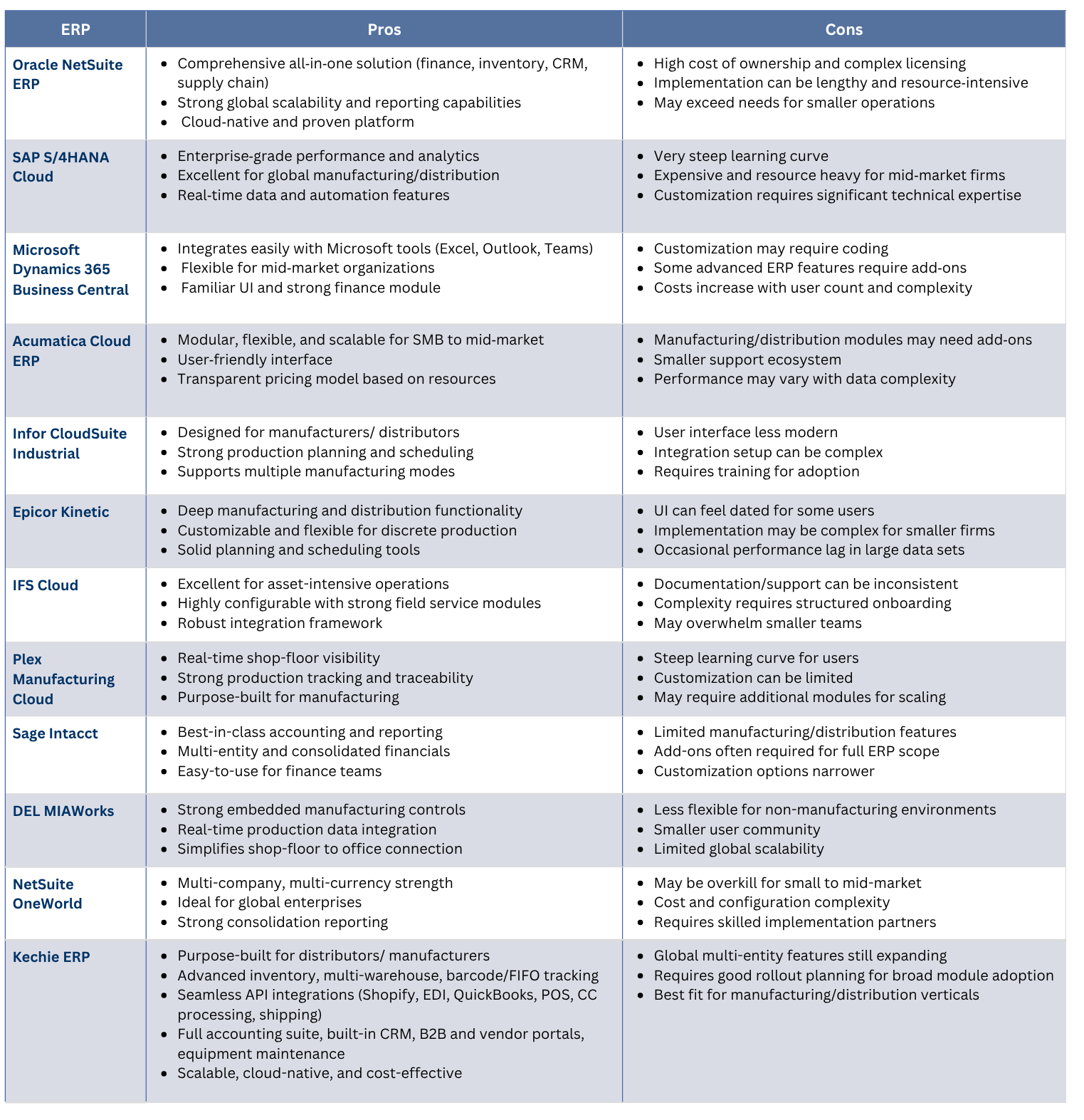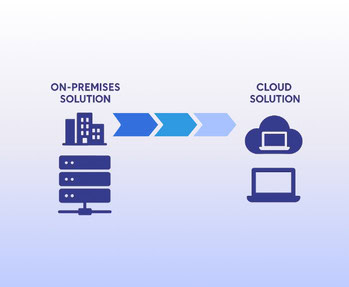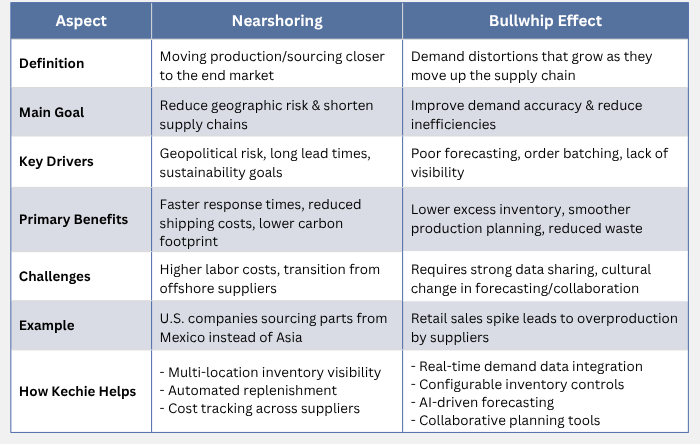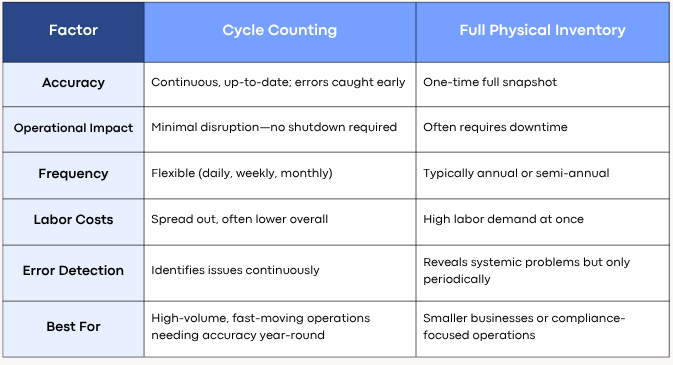Top 12 Cloud-Based ERP Systems: Pros & Cons Comparison
Top 12 Cloud-Based ERP Systems: Pros & Cons Comparison
Explore key strengths, limitations, and why Kechie stands out with an integrated, industry-specific approach.
Contact us today to learn more about how Kechie ERP can transform your inventory management practices!
The Future of ERP: AI, Automation & Analytics
The Future of ERP: AI, Automation, and Analytics Powering the Next Generation of Business
The Future Is Already Here — It’s Just Unevenly Adopted
Walk into two manufacturing or distribution companies today, and you might feel like you’ve stepped into different decades.
One is buried in spreadsheets, manual reporting, and reactive decision-making. The other is running on predictive analytics, automated workflows, and real-time insights.
The difference isn’t just technology — it’s transformation.
This is the next era of Enterprise Resource Planning (ERP), where Artificial Intelligence (AI), automation, and analytics are reshaping how businesses operate.
Cloud-based systems like Kechie ERP are leading this shift, combining intelligence and integration to help growing manufacturers and distributors operate smarter, faster, and more profitably.
1. From Data Collection to Data Intelligence
Traditional ERP systems were designed to collect and store data.
But modern businesses don’t just need data — they need insight.
AI-driven ERP platforms like Kechie transform raw information into real-time intelligence.
They analyze sales trends, production metrics, and supplier performance to uncover patterns that would otherwise go unnoticed.
For example, Kechie can highlight when a particular supplier’s lead time is rising or when a product’s margins are tightening — before those issues affect your bottom line.
This is the shift from reactive to predictive — from hindsight to foresight.
2. Automation: Doing More With Less Manual Effort
Manual tasks slow teams down and invite mistakes.
Modern ERP automation takes care of those repetitive, time-consuming jobs — freeing employees to focus on strategy and service.
Kechie automates key workflows across operations:
- Reordering materials when inventory hits predefined thresholds
- Approving purchase orders or invoices based on set rules
- Generating and sending recurring reports automatically
The result? Fewer errors, faster turnaround times, and consistent accuracy across every department.
Automation doesn’t replace people — it empowers them.
3. Predictive Analytics and Smarter Decision-Making
Data becomes powerful when it helps you make the right call before problems arise.
Kechie’s built-in analytics engine uses predictive modeling to forecast demand, optimize production, and identify cost-saving opportunities.
Distributors can anticipate which SKUs are likely to run low.
Manufacturers can plan production around upcoming spikes in demand.
These insights let leaders move from reacting to issues to strategically planning around them — saving time, money, and stress.
4. AI-Powered Forecasting and Resource Planning
Artificial Intelligence is rapidly becoming the brain of ERP systems.
It doesn’t just process data — it learns from it.
Kechie uses AI algorithms to:
- Improve forecasting accuracy
- Spot inefficiencies in production or purchasing
- Recommend the optimal reorder quantities
- Suggest supplier alternatives based on performance history
With AI guiding decisions, manufacturers and distributors can better balance supply and demand, manage costs, and keep customers satisfied.
5. Connected Ecosystems and API-Driven Integrations
No business operates in isolation — and your ERP shouldn’t either.
The future of ERP lies in API-driven integration, where systems communicate fluidly and data flows seamlessly between tools.
Kechie ERP is built to connect your entire operation. It integrates smoothly with:
- Shopify for eCommerce and order management
- EDI platforms for supplier and retailer data exchange
- QuickBooks for financial synchronization
- POS systems for real-time sales visibility
- Credit card processing tools for streamlined transactions
- Shipping solutions for end-to-end fulfillment tracking
And because Kechie also includes its own CRM, you get one unified platform for customer management, sales tracking, and operational execution.
Every part of your business — from order intake to delivery — runs in perfect sync.
6. Cloud Infrastructure and Continuous Improvement
The cloud was the foundation of ERP’s evolution — but now it’s also the catalyst for ongoing innovation.
With Kechie’s cloud-native architecture, updates happen automatically, without disrupting daily work. You’re always on the latest version, always secure, and always benefiting from new capabilities.
Cloud infrastructure also supports the computing power required for AI and advanced analytics — enabling constant optimization and scalability without hardware limitations.
7. Mobile ERP and Real-Time Accessibility
In today’s distributed work environment, teams need to stay connected no matter where they are.
Kechie’s mobile-friendly design allows users to manage orders, approve transactions, and access dashboards from any device.
Warehouse managers can update inventory levels from the floor.
Sales reps can check customer histories before meetings.
Executives can track KPIs on the go.
Mobility means visibility — and visibility means control.
8. Sustainability and Smart Resource Management
Future-ready ERP systems are helping companies reduce waste, cut emissions, and optimize resource use.
With Kechie, manufacturers and distributors can:
- Track production efficiency and scrap levels
- Monitor supplier sustainability metrics
- Optimize shipping routes to lower fuel usage
By aligning operational efficiency with environmental responsibility, businesses can achieve growth that’s both profitable and sustainable.
9. The Human Side of ERP Innovation
Technology is only as valuable as the people who use it.
AI and automation aren’t replacing human intelligence — they’re amplifying it.
Kechie’s intuitive design helps every user — from warehouse teams to executives — make data-driven decisions with ease.
Instead of chasing down reports, employees can focus on improvement and innovation.
That’s the real magic of ERP evolution: people and technology working in harmony.
10. The Road Ahead: Smarter, Simpler, Seamlessly Connected
The next generation of ERP will be more intelligent, adaptive, and collaborative than ever before.
Businesses that adopt these innovations early — AI forecasting, API integrations, real-time analytics — will gain an advantage that compounds over time.
Kechie ERP embodies that future:
- Intelligent automation for speed and precision
- Real-time analytics for smarter planning
- Seamless integrations for a unified business experience
It’s not just an ERP system — it’s a growth platform designed for the modern manufacturer and distributor.
Conclusion: The Future Belongs to the Insight-Driven
The future of ERP isn’t about more technology — it’s about more clarity.
AI, automation, and connected integrations are helping businesses see further, react faster, and grow smarter.
Kechie ERP makes that future tangible — today.
By combining intelligent automation, predictive analytics, and seamless integrations, it gives you the power to make better decisions, reduce costs, and stay agile in an unpredictable world.
If you’re ready to see how technology can empower your business — not overwhelm it — the future is already waiting.
And with Kechie, it’s within reach.
Contact us today to learn more about how Kechie ERP can transform your inventory management practices!
How to Migrate from On-Premise ERP to Cloud
How to Migrate from On-Premise ERP to the Cloud — A Step-by-Step Guide
You Know It’s Time for a Change — Here’s How to Make It Smooth
In our last article, we explored the advantages of cloud ERP systems and how they help growing manufacturers and distributors stay competitive.
Now, let’s tackle the question that comes next for many business owners:
“How do we actually move from our old, on-premise ERP to the cloud?”
For most companies, the move to cloud ERP feels both exciting and intimidating. The promise of better visibility and automation is huge — but so are the concerns about data migration, downtime, and team adoption.
The good news? With the right plan, partner, and preparation, the transition can be smooth, efficient, and even energizing for your entire organization.
Here’s a practical step-by-step guide to help you migrate confidently — and how solutions like Kechie make it easier.
Step 1: Evaluate Your Current ERP System
Before making any move, take an honest look at where you stand.
What’s working in your current ERP — and what’s not?
Ask questions like:
- Are there data silos between departments?
- Is it difficult to access reports or analytics?
- Does the system require manual updates or IT support?
- Are maintenance costs rising each year?
This evaluation will help you pinpoint the gaps that cloud ERP can fill. Many manufacturers and distributors realize that their old systems simply can’t keep up with their growth. Kechie’s team often begins engagements with a thorough discovery process to uncover these inefficiencies before migration even begins.
Step 2: Define Clear Goals and Success Metrics
Migration isn’t just about moving data — it’s about improving how you work.
Start by setting measurable goals:
- Faster order processing times
- Reduced inventory discrepancies
- Better access to real-time financial data
- Lower operational costs
With Kechie, goal setting is built into the implementation plan. Their experts help align your ERP configuration with your unique business processes — ensuring you’re not just transferring information but transforming how your teams operate.
Step 3: Choose the Right Cloud ERP Partner
The partner you choose determines how easy (or painful) your migration will be.
Look for a solution that offers:
- Industry expertise in manufacturing and distribution
- Proven migration tools and data mapping capabilities
- Secure, cloud-native architecture
- Responsive support and onboarding assistance
Kechie was built specifically for these industries, so it understands the complexity of multi-warehouse operations, FIFO tracking, and inventory management. More importantly, Kechie’s migration process is guided — meaning you have a clear roadmap, from setup to go-live.
Step 4: Prepare and Cleanse Your Data
This is the step where many migrations succeed or fail.
Your new ERP system is only as good as the data you bring into it.
Take the time to:
- Eliminate duplicate or outdated records
- Standardize naming conventions and units of measure
- Validate key fields (SKUs, supplier IDs, customer codes)
- Back up all existing data
Kechie’s implementation team uses automated tools to help clean and structure data before import — ensuring that once your cloud system is live, everything is consistent, accurate, and ready to go.
Step 5: Plan Your Implementation Timeline
Every company’s migration timeline looks different. Some opt for a phased rollout, starting with finance and inventory before expanding into CRM or production. Others prefer a big-bang approach — migrating everything at once for a faster transition.
Cloud ERP makes both possible. Because it’s hosted online, there’s no need for complex server setup or software installation.
Kechie supports both phased and full implementations, helping you pick the best fit for your resources, data complexity, and comfort level.
Step 6: Test Thoroughly Before You Go Live
Testing is where you build confidence.
Create a sandbox or test environment that mirrors your live setup. Have users from each department walk through their day-to-day tasks — entering orders, running reports, adjusting inventory.
This “dress rehearsal” will surface small issues early, allowing you to fine-tune workflows and permissions.
With Kechie, testing and validation are built into the onboarding process, ensuring your system is stable before flipping the switch.
Step 7: Train Your Team Early and Often
Even the best software fails if users aren’t comfortable with it.
That’s why training is one of the most critical (and often underestimated) steps in any ERP migration.
Kechie’s interface is designed for simplicity, but effective adoption still requires guidance.
Offer hands-on sessions by role — finance, operations, warehouse, etc. — and create “super users” within each team who can act as internal champions.
When people see how much time the system saves them, they embrace it quickly.
Step 8: Go Live With Confidence
Once testing and training are complete, it’s time to go live.
On launch day:
- Ensure all integrations are working (accounting, CRM, eCommerce).
- Monitor transactions closely for accuracy.
- Keep your old system available temporarily, just in case.
With cloud ERP, there’s no lengthy downtime or hardware transition. You simply log in to your new system — and start working smarter. Kechie’s implementation specialists typically stay closely involved during the first few weeks after go-live to handle questions, adjustments, or unexpected issues.
Step 9: Monitor, Measure, and Optimize
Migration doesn’t end at go-live. It’s an ongoing process of improvement.
Once your system is running, track key performance indicators (KPIs) such as:
- Order-to-cash cycle time
- Inventory turnover rate
- Forecast accuracy
- Customer satisfaction
These metrics show the tangible ROI of your ERP investment.
Kechie’s built-in analytics dashboards make it easy to visualize these metrics and identify opportunities for further automation or efficiency gains.
Step 10: Avoid Common Migration Pitfalls
Here are some common mistakes companies make — and how to avoid them:
- Rushing data migration without cleaning your records
- Skipping user testing, which can lead to confusion post-launch
- Ignoring change management, causing low adoption rates
- Not allocating enough resources for ongoing optimization
Remember: a well-planned migration is not just an IT project — it’s an operational transformation. Take your time to get it right.
Why Moving to Kechie Makes Migration Easier
Migrating to the cloud doesn’t have to be painful — especially with a system designed to make it simple.
Kechie is 100% cloud-native, so there’s no hardware setup or version management. Its modular design means you can migrate in phases, starting with the areas that bring the fastest ROI.
And with hands-on support from experienced ERP specialists, you’ll have guidance at every step.
Many manufacturers and distributors report that after migrating to Kechie, they not only streamlined their operations but also uncovered insights they’d never had before — turning what used to be chaos into clarity.
Conclusion: A Smarter Way to Modernize
Migrating from an on-premise ERP to the cloud may sound daunting, but in reality, it’s one of the smartest moves a growing business can make.
It’s not just about upgrading your software — it’s about unlocking speed, scalability, and data-driven decision-making.
With the right strategy, partner, and preparation, your ERP migration can be smooth, predictable, and transformative.
Kechie ERP helps make that possible — guiding you from planning to go-live and beyond with a platform built to support real growth.
If you’re ready to leave legacy systems behind and embrace the future, now’s the time to start your cloud ERP journey — one smart step at a time.
Contact us today to learn more about how Kechie ERP can transform your inventory management practices!
10 Advantages of Cloud ERP for Growing Manufacturers and Distributors
10 Advantages of Cloud ERP for Growing Manufacturers and Distributors
If You Think ERP Is Just About Data, Think Again
In our last article, we explored what a cloud-based ERP is and how it works.
Now, let’s talk about why it matters — especially for manufacturers and distributors who are growing fast and trying to stay ahead of complexity.
For many businesses, success brings new challenges: too many spreadsheets, disconnected systems, and limited visibility. Operations start to feel like a game of catch-up. That’s when modern, cloud-based ERP solutions like Kechie become a game-changer.
Below are ten real-world advantages that explain why cloud ERP isn’t just a technology upgrade — it’s a growth strategy.
1. Real-Time Visibility Across Your Entire Business
When your systems talk to each other, everything changes.
A cloud ERP like Kechie gives you one source of truth for your data — from production to finance to inventory.
Instead of waiting for weekly reports, you can see what’s happening right now. Inventory levels, order status, production bottlenecks, and customer trends update in real time.
For high-growth companies, this visibility helps leaders spot inefficiencies, pivot quickly, and make smarter, faster decisions.
2. Flexibility That Grows With You
Growth is exciting — until your systems can’t keep up.
Cloud ERP scales effortlessly. Need to add a new warehouse, product line, or user group? It takes minutes, not months.
With Kechie, manufacturers and distributors can expand without worrying about installing new servers or disrupting operations. You start with the modules you need and add more as you grow — finance, inventory, CRM, purchasing, or production.
That flexibility keeps your business nimble, even as complexity increases.
3. Lower Total Cost of Ownership
Traditional ERP systems often require big upfront costs: servers, hardware, dedicated IT staff, and long implementation cycles.
Cloud ERP flips that model. With Kechie, there’s no heavy infrastructure to maintain. The system is web-based and subscription-driven, so you only pay for what you use.
Updates, backups, and security are handled automatically — freeing your team to focus on running the business, not running the software.
4. Faster Implementation and Easier Upgrades
On-premise ERP implementations can take months — sometimes even a year. Cloud ERP solutions are far quicker to deploy because there’s no hardware setup or manual configuration.
Kechie’s cloud deployment model means you can be up and running in a fraction of the time.
And when it’s time for upgrades, they happen behind the scenes. No downtime. No disruptions. Just the newest features, automatically applied.
5. Enhanced Collaboration Across Teams
For many companies, data lives in silos — accounting has one version, operations another, sales a third. That disconnect leads to delays, errors, and frustration.
Cloud ERP solves this by connecting everyone on the same platform.
Your sales team can check inventory before quoting a customer. Your production team can see new orders instantly. Finance can reconcile transactions in real time.
Kechie takes this a step further with role-based dashboards, so each department sees what matters most to them — without being overwhelmed by irrelevant data.
6. Improved Inventory Control and Supply Chain Management
Inventory is often where profits leak unnoticed — too much stock, slow turnover, or misplaced items.
Cloud ERP systems like Kechie give you complete visibility and control. You can track inventory across multiple warehouses, automate reordering, and even use FIFO (First-In, First-Out) tracking for perishable or high-turnover items.
For distributors, that means fewer stockouts and happier customers. For manufacturers, it means smarter production planning and lower carrying costs.
7. Seamless Integration With Other Business Tools
Modern businesses rely on multiple platforms — accounting software, eCommerce, CRMs, logistics systems. The problem is, those tools rarely talk to each other.
Kechie is built to integrate seamlessly with platforms like QuickBooks Online, Shopify, and other cloud applications.
That means no double data entry, fewer errors, and a single connected workflow from order to fulfillment.
8. Security and Data Protection You Can Trust
Some businesses hesitate to move to the cloud because they worry about security. The reality?
Top-tier cloud ERP systems are often more secure than on-premise ones.
Kechie uses enterprise-grade encryption, regular security audits, and redundant data backups in secure data centers.
Unlike a local server, which can fail or be breached, cloud environments are monitored continuously and updated automatically.
In today’s world of cyber threats and data regulations, that peace of mind is invaluable.
9. Continuous Innovation and Future-Ready Features
The beauty of cloud software is that it never stops evolving.
Kechie continuously updates its platform, rolling out new features that leverage AI, automation, and analytics — without requiring any manual installations or upgrades from your side.
That means your ERP grows smarter over time.
As manufacturing and distribution trends shift — from IoT connectivity to predictive analytics — your business stays ahead, not behind.
10. Better Decision-Making Through Real-Time Insights
At the end of the day, cloud ERP is about making better decisions faster.
Instead of relying on static reports, you get live dashboards that show what’s really happening across your business.
Kechie’s analytics tools let you track KPIs like inventory turnover, order fulfillment rates, and gross margin — all in real time.
That level of insight empowers leaders to act proactively, not reactively. You can identify inefficiencies, fine-tune operations, and seize opportunities before competitors do.
The Ripple Effect: How These Advantages Multiply
Each of these ten advantages is powerful on its own — but together, they transform how your business operates.
- Real-time data fuels faster, more confident decisions.
- Automation reduces manual work and human error.
- Integration breaks down silos between teams.
- Scalability ensures you’re never stuck with yesterday’s system.
In other words, cloud ERP gives growing companies the kind of agility that used to be reserved for enterprise giants.
When your systems are connected, your team aligned, and your data reliable, growth stops feeling chaotic — and starts feeling controlled.
Why Kechie Stands Out
Plenty of ERP solutions promise cloud flexibility. Few are built from the ground up with distributors and manufacturers in mind.
Kechie ERP is designed specifically for the challenges you face every day:
- Managing inventory across multiple warehouses
- Handling high order volumes
- Coordinating production and purchasing efficiently
- Keeping costs down while scaling up
Its modular design means you can start small — and grow without ever outgrowing your system.
And because it’s truly cloud-native, Kechie delivers updates, integrations, and innovations continuously — ensuring your business is always equipped with the best tools available.
The Bottom Line
For fast-growing manufacturers and distributors, cloud ERP isn’t just a nice-to-have — it’s the foundation of sustainable growth.
It connects every corner of your operation, cuts down on wasted time and resources, and gives you the data clarity you need to make confident moves.
Kechie brings all these advantages together in one flexible, scalable, and secure platform built for the realities of modern business.
If you’re ready to move beyond spreadsheets and fragmented systems, now’s the time to explore how cloud ERP can help you operate smarter, faster, and stronger.
Contact us today to learn more about how Kechie ERP can transform your inventory management practices!
Cloud-Based ERP Explained: How Kechie Empowers Manufacturers & Distributors
What Is a Cloud-Based ERP and How Does It Work? A Modern Guide for Growing Manufacturers and Distributors
The Manufacturing World Has Changed — Has Your Software?
Walk into almost any warehouse or production floor today, and you’ll hear the same story:
Operations are busier than ever, customer expectations are higher than ever, and spreadsheets just can’t keep up.
For growing manufacturers and distributors, the real bottleneck isn’t in the warehouse — it’s in the software.
That’s why so many are making the move to cloud-based ERP systems like Kechie.
Cloud ERP isn’t just another tech buzzword. It’s a complete shift in how businesses run their day-to-day operations, manage data, and make decisions. It’s what happens when modern software finally catches up with how fast you need to move.
So, What Exactly Is a Cloud-Based ERP?
Let’s start simple.
ERP, or Enterprise Resource Planning, is the software that keeps your entire business connected — finance, inventory, purchasing, sales, production, customer management, and more.
A cloud-based ERP does everything a traditional ERP does, except it runs in the cloud — meaning it’s hosted online instead of on servers in your office.
That one difference changes everything.
No bulky hardware. No constant IT maintenance. No waiting for software updates or worrying about backups.
You log in from anywhere — whether you’re in the office, on the road, or walking the floor — and you’re in.
Cloud ERP systems like Kechie bring all your critical business data into one centralized platform, updated in real time. Every department sees the same truth — no version conflicts, no duplicate entries, and no surprises.
Why Manufacturers and Distributors Are Moving to the Cloud
The manufacturing and distribution sectors have always run on precision. But growth introduces complexity — more warehouses, more SKUs, more suppliers, more moving parts.
Traditional systems, especially on-premise ones, just can’t keep up with that pace.
Here are the biggest reasons why companies are making the switch:
1.Visibility You Can Actually Use
Imagine knowing your exact inventory levels, order status, and cash flow at any given moment — across every warehouse or location.
That’s the power of cloud ERP.
With real-time dashboards and reports, you don’t have to wait until the end of the week or month to see what’s really happening.
Kechie, for example, lets you track production runs, shipments, and financial metrics from one interface. You can spot bottlenecks before they turn into problems and make faster, smarter decisions.
2. It Grows When You Do
Growth should be exciting — not a logistical nightmare.
Cloud ERP scales naturally. Need to add a new warehouse? Hire a new sales team? Launch a new product line? You can expand your ERP with a few clicks instead of a full IT project.
That flexibility is crucial for distributors and manufacturers who often need to pivot quickly to meet customer demand or supply chain changes.
3. Fewer IT Headaches (and Costs)
Maintaining on-premise servers and outdated software is expensive — not just in dollars, but in time. Cloud ERP eliminates that overhead. Updates, backups, and security are handled by the provider.
Your team can focus on what they do best: building products, fulfilling orders, and growing the business.
4. A System That Moves as Fast as You Do
Because cloud ERP systems are web-based, your team can access information anytime, anywhere — whether they’re at a supplier site, customer meeting, or trade show.
Remote collaboration becomes seamless. Your sales, warehouse, and finance teams can finally stay in sync without endless email chains or spreadsheets.
How Does Cloud ERP Actually Work?
At a high level, a cloud-based ERP connects every part of your business through one central database hosted online.
Each department — from purchasing to accounting to operations — works from that same live data set.
Here’s a simplified view of how it all ties together:
1. Data Flows in Real Time
Every time an order is placed, inventory is updated, or a payment is processed, that data instantly updates across the entire system.
If a product ships out, accounting sees it, sales sees it, and the warehouse knows immediately — no lag, no duplicate entry.
2. Role-Based Access Keeps Things Secure
Each team or role gets access only to what they need. Warehouse staff can manage inventory. Finance handles ledgers. Executives see everything in summary.
Cloud ERPs like Kechie use enterprise-grade encryption and secure data centers to keep everything safe.
3. Modular Design Means Flexibility
You don’t have to buy everything at once.
Start with the core modules — like inventory, purchasing, and accounting — and add others (like CRM, manufacturing, or supply chain management) when you’re ready.
Kechie’s modular structure makes it easy to tailor the system to how your business actually works, not the other way around.
From Manual Processes to Real-Time Control
Let’s put this into perspective with a real-world scenario.
Say you’re a growing distributor managing three warehouses and hundreds of product SKUs. You rely on spreadsheets and a patchwork of legacy software to track orders, shipments, and inventory.
By the time your team reconciles the numbers, something’s already out of date.
Now imagine running all that through a cloud ERP like Kechie.
When an order comes in, inventory adjusts automatically. The purchasing module sees when it’s time to reorder. The warehouse gets pick-and-pack instructions instantly. Finance tracks the transaction in real time.
That’s not just automation — that’s control.
And it’s why distributors and manufacturers are embracing the cloud. They’re not just buying software; they’re building smarter, leaner operations.
Key Benefits of Cloud ERP (and Why They Matter)
1. Real-Time Insight for Faster Decisions
With a cloud ERP, you don’t wait for reports — you see everything as it happens. You know what’s selling, what’s stuck in production, and what needs attention.
That visibility helps leaders make proactive decisions instead of reactive ones.
2. Streamlined Inventory and Supply Chain Management
ERP systems like Kechie are designed for complex supply chains. They support FIFO tracking, barcode scanning, and serial number control. You can see exactly where every item is — from supplier to shelf — and plan production with confidence.
3. Lower Total Cost of Ownership
Forget about costly hardware or IT teams managing servers. With a subscription model, you pay for what you use and can scale up or down as needed.
No big upgrades, no surprise maintenance bills.
4. Seamless Integrations
Modern ERPs don’t exist in isolation. They integrate with your accounting, CRM, and eCommerce tools. For example, Kechie connects with systems like Shopify and QuickBooks Online, creating a unified data environment that saves time and prevents costly errors.
5. Security and Peace of Mind
Cloud ERP vendors invest heavily in cybersecurity. Your data is encrypted, backed up automatically, and stored in secure data centers — usually far more protected than an on-site server could ever be.
Migrating from On-Premise to Cloud: What to Expect
Moving to a new ERP system sounds intimidating, but it’s a lot smoother than most companies expect — especially when guided by experienced implementation partners.
Here’s what the process usually looks like:
1. Assess Your Current Systems — Identify what’s working, what isn’t, and where bottlenecks exist.
2. Set Clear Goals — Define what success looks like: faster order processing, better inventory accuracy, or improved reporting.
3. Plan Data Migration — Clean your data before importing it. It’s the best time to eliminate duplicates and outdated records.
4. Train Your Team — The best ERP is the one your team actually uses. Involve them early, provide role-based training, and gather feedback during rollout.
5. Go Live and Optimize — Once live, monitor performance and tweak workflows. With a cloud ERP like Kechie, updates and improvements are continuous.
The Future of ERP: Smart, Connected, and Data-Driven
ERP software isn’t just evolving — it’s transforming.
Here’s where things are headed:
- Artificial Intelligence (AI): Predictive analytics help forecast demand, optimize production schedules, and automate purchasing.
- IoT Connectivity: Machines and sensors feed live data directly into ERP systems for real-time monitoring.
- Automation Everywhere: From purchase orders to shipping notifications, manual tasks are being replaced by smart workflows.
- Deeper Customization: APIs allow businesses to connect ERP with specialized tools and build unique extensions.
Platforms like Kechie are already embedding these capabilities — making them not just management systems, but strategic growth engines.
Why Cloud ERP Is the Smartest Move for Growth
At some point, every growing manufacturer and distributor hits a wall — the one where spreadsheets, disconnected tools, and outdated systems start holding you back.
That’s when cloud ERP becomes more than a software choice. It becomes a growth strategy.
Cloud-based systems give you:
- Control of your entire operation in one place
- Real-time data to make better decisions
- Flexibility to scale without disruption
- Confidence that your technology will keep up with your ambition
In short, cloud ERP lets you focus on what you do best — building great products, delivering on time, and growing your business.
Final Thought
The businesses that thrive in the next decade won’t be the ones that work harder — they’ll be the ones that work smarter.
Cloud ERP solutions like Kechie make that possible by bringing together every piece of your operation into one intelligent, accessible system.
If your current tools are limiting your visibility or slowing your growth, it might be time to look at how cloud ERP can help you move faster, scale easier, and compete stronger.
Contact us today to learn more about how Kechie ERP can transform your inventory management practices!
Kechie ERP- Turning Supply Chain Chaos into Clarity
Kechie ERP- Turning Supply Chain Chaos into Clarity
If you’ve ever had to tell a customer, “Sorry, we thought we had it in stock”, you know the pain of poor visibility. Maybe your system said you had 100 units, but the warehouse floor told a different story. Or a supplier missed a deadline, and you only found out when your production line came to a halt.
Sound familiar? For many companies, this is just business as usual when supply chains are run on spreadsheets and outdated systems. The problem is, with disruptions coming from every direction, those small cracks quickly turn into big headaches.
This is why more businesses are turning to Kechie ERP — a modern, cloud-based solution that doesn’t just patch problems but transforms the way supply chains operate.
Problem 1: Blind Spots Everywhere
You can’t fix what you can’t see. And without real-time data, supply chains are full of blind spots:
• Inventory counts that don’t match reality
• Supplier delays that catch you by surprise
• Shipments that vanish into a black hole of tracking numbers
These blind spots lead to rushed orders, costly mistakes, and frustrated customers.
Kechie’s Fix: Real-Time Visibility
Kechie ERP gives you a clear window into your supply chain, updated in real time. You can see:
• Inventory across all warehouses and locations
• Supplier performance and lead times
• Shipments as they move from dock to doorstep
• Customer demand as it happens
Instead of reacting after the fact, you’re in control from the start.
Problem 2: Inventory Inaccuracy & the Bullwhip Effect
One small miscalculation in demand can ripple through your supply chain like a whip — suppliers overproduce, warehouses overstock, and suddenly you’re sitting on piles of inventory you don’t need while running out of what customers actually want.
This bullwhip effect is a silent profit killer.
Kechie’s Fix: Smarter Inventory Management
Kechie ERP is built to stop the bullwhip effect in its tracks with:
• Configurable Cycle Counting — keep records accurate by scheduling counts by ABC code, item, category, or location.
• Forecasting & Analytics — use AI-driven insights to predict demand more accurately.
• Unified Data — connect sales, purchasing, and inventory so everyone sees the same numbers.
No more guesswork. No more overreactions. Just the right stock in the right place, at the right time.
Problem 3: Siloed Systems & Manual Work
In many organizations, finance, inventory, sales, and logistics all run on different platforms. Teams spend hours reconciling data, chasing errors, and trying to figure out which numbers are correct.
The result? Wasted time, duplicate work, and frustrated employees.
Kechie’s Fix: One Unified System
Kechie ERP replaces the patchwork of tools with one connected platform that covers:
• Inventory & Warehouse Management
• Procurement & Supplier Tracking
• Sales & Order Processing
• Logistics & Distribution
• Finance & Reporting
One login. One database. One version of the truth.
Problem 4: Customers Expect More
Today’s customers expect transparency. They want to know where their order is, when it will arrive, and why a delay happened. Businesses that can’t deliver that level of communication risk losing trust.
Kechie’s Fix: Reliable Customer Experiences
Kechie ERP helps you meet — and exceed — those expectations by:
• Providing real-time shipment updates
• Triggering alerts when problems arise
• Keeping products available when customers need them
• Building confidence with consistent, reliable service
When you communicate clearly and deliver consistently, customers stick around.
From Problems to Opportunities
Let’s be honest: disruptions aren’t going away. Supply chains will always face risks, sudden shifts, and rising expectations. The difference between businesses that struggle and those that thrive is the tools they use.
With Kechie ERP, the story changes:
• Blind spots turn into clear visibility
• Guesswork turns into accurate forecasting
• Silos turn into seamless integration
• Frustration turns into customer trust
Kechie doesn’t just solve problems. It gives you a competitive edge.
Next Steps: Still running your supply chain on spreadsheets or outdated systems? It’s time to see how Kechie ERP can give you the clarity, control, and confidence you’ve been missing.
Contact us today to learn more about how Kechie ERP can transform your inventory management practices!
The Power of Real-Time Data: Kechie ERP
The Power of Real-Time Data: Why Visibility Is the New Currency of Supply Chains
A few years ago, “out of stock” used to be a temporary problem. Today, it can mean losing a customer for good.
Supply chains aren’t just about moving boxes anymore — they’re about moving information. A late shipment, a sudden demand spike, a missing pallet… these things used to take days to discover. Now, in a world that moves at the speed of a click, you can’t afford to find out tomorrow what went wrong today.
That’s why real-time data has quietly become the new currency of supply chains. The companies that can see, react, and adapt the fastest are the ones winning customer trust — and keeping it.
Seeing Is Surviving
We throw around the word “visibility” all the time, but what does it really mean?
It’s not just knowing what’s in the warehouse. It’s about seeing everything — what’s on order, what’s delayed, what’s selling faster than expected, and what’s about to run out. It’s about having answers when someone asks, “Where’s that shipment?”, instead of promising to “check with the team.”
True visibility means your entire operation — suppliers, logistics, warehouse staff, and even customers — is looking at the same live picture.
Without it, you’re flying blind.
Real-Time Data Changes Everything
1. You Stay Ahead of Problems
Disruptions aren’t optional — they happen every day. But with real-time data, you can see trouble coming before it lands. A delayed truck or supplier hiccup doesn’t have to snowball into a crisis.
2. Inventory Finally Makes Sense
How many businesses overstock one product and run out of another? Real-time visibility keeps you balanced — you buy what you need, when you need it, and stop guessing.
3. Suppliers Become Partners, Not Headaches
When your suppliers can see what you see, they stop guessing too. Transparency builds trust and helps everyone plan better — no more frantic last-minute emails.
4. Customers Actually Relax
People don’t expect perfection; they expect honesty. If you can tell them where their order is and when it will arrive, they’ll give you something far more valuable than one sale — they’ll give you loyalty.
The Cost of Staying in the Dark
Most companies still run their operations on spreadsheets, outdated ERP tools, or systems that don’t talk to each other. It’s like trying to play chess while someone keeps moving your pieces when you’re not looking.
Here’s what happens when you don’t have real-time visibility:
- The bullwhip effect — a small change in demand turns into a big mess upstream.
- Inventory chaos — too much of what you don’t need, not enough of what you do.
- Lost time — teams chasing numbers that are already outdated.
- Frustrated customers — because no one can give them straight answers.
It’s not that people are making bad decisions — they’re just making them too late.
Where Kechie Fits In
This is where Kechie ERP steps in — not as another piece of software, but as the central nervous system of your business.
Kechie connects the dots across your entire operation, giving you a live view of what’s happening in real time — from warehouse floor to supplier network to customer delivery.
Here’s how it changes the game:
- Live Inventory Tracking: No more surprises. Know what you have, where it is, and what’s moving fast.
- Configurable Cycle Counting: Keep data accurate daily, weekly, or by category, so your numbers actually mean something.
- Connected Data Streams: Sales, purchasing, logistics, and finance finally speak the same language.
- Smart Forecasting: Kechie uses data to predict what’s coming next — before it happens.
- Supplier & Shipment Monitoring: See the whole journey, not just your part of it.
Kechie doesn’t just give you data — it gives you clarity. It turns your supply chain from reactive to proactive, from guessing to knowing.
Visibility Is the Real Competitive Advantage
We’ve entered an era where speed and transparency matter more than size. The best supply chains aren’t the biggest — they’re the ones that can see clearly and act fast.
That’s the beauty of real-time data. It levels the playing field.
And with Kechie ERP, businesses of any size can play like the big leagues — confident, connected, and in control.
Next Steps: Still relying on yesterday’s reports to make today’s decisions? It’s time to see how Kechie ERP brings your supply chain into focus — in real time.
Contact us today to learn more about how Kechie ERP can transform your inventory management practices!
Supply Chain Resilience: Nearshoring Trends & Bullwhip Effect
Supply Chain Resilience in 2025: Nearshoring Trends & the Bullwhip Effect
The past few years have been a wake-up call for global supply chains. From pandemic disruptions to geopolitical tensions and extreme weather events, companies have realized that resilience is no longer optional — it’s essential. Two of the most important strategies in this conversation are nearshoring and managing the bullwhip effect.
In this article, we’ll explain what these terms mean, why they matter, and how modern ERP and supply chain software like Kechie ERP can help companies adapt and thrive.
Nearshoring Trends: Bringing Production Closer to Home
For decades, companies prioritized low-cost, offshore manufacturing hubs — particularly in Asia. While this strategy helped cut expenses, it also created long, fragile supply chains vulnerable to disruption.
Now, businesses are turning to nearshoring: shifting production and sourcing closer to their main markets. For example, U.S. firms are increasingly working with suppliers in Mexico and Latin America, while European companies are exploring Eastern Europe and North Africa.
Why Nearshoring is Gaining Momentum
1. Risk Reduction: Shorter supply chains mean fewer disruptions from shipping delays, port congestion, or global conflicts.
2. Faster Response Times: Being closer to customers allows for quicker replenishment and more agile demand planning.
3. Balanced Costs: While labor may be higher than in offshore regions, savings in transportation, tariffs, and lost sales often offset the difference.
4. Sustainability: Nearshoring reduces carbon footprints by cutting down on long-haul shipping routes.
Example in Action
Several U.S. automakers have shifted parts production to Mexico. The shorter distance allows for just-in-time manufacturing and reduces the risk of supply shortages caused by overseas shipping delays.
The Bullwhip Effect: A Hidden Supply Chain Challenge
While nearshoring helps reduce physical risks, companies must also deal with information distortions in their supply chains. That’s where the bullwhip effect comes in.
The bullwhip effect happens when small changes in customer demand trigger increasingly larger fluctuations as they move up the supply chain. A slight sales spike at retail level can lead distributors, manufacturers, and suppliers to overreact — creating excess inventory, inflated costs, and inefficiency.
Common Causes of the Bullwhip Effect
- Inaccurate Forecasting: Over-reliance on short-term sales spikes.
- Order Batching: Placing large, infrequent orders instead of smaller, steady ones.
- Price Distortions: Discounts or promotions that cause artificial demand.
- Lack of Transparency: Poor communication between retailers, distributors, and suppliers.
Ways to Minimize the Bullwhip Effect
1. Data Sharing: Improve visibility with connected ERP systems.
2. Smarter Forecasting: Use AI and analytics to improve demand predictions.
3. Frequent Orders: Smaller, more regular orders help smooth demand.
4. Collaborative Planning: Models like CPFR (Collaborative Planning, Forecasting, and Replenishment) keep partners aligned.
Nearshoring vs. Bullwhip Effect: A Side-by-Side Comparison
How ERP & Supply Chain Software Like Kechie Helps
Resilience isn’t just about strategy — it’s about execution. This is where modern ERP, inventory management, and supply chain software come in. A platform like Kechie ERP gives businesses real-time visibility, automation, and control to put these strategies into action.
Supporting Nearshoring Strategies
- Multi-Location Visibility: Track inventory across nearshored warehouses or facilities in real time.
- Faster Replenishment: Automate order workflows to keep products moving smoothly between regional suppliers and customers.
- Cost Tracking: Monitor landed costs, tariffs, and supplier performance to confirm the ROI of nearshoring.
Reducing the Bullwhip Effect
- Real-Time Demand Data: Kechie connects sales, inventory, and purchasing in one system so all partners see the same demand signals.
- Configurable Controls: Set rules for cycle counts, replenishment, and safety stock by ABC code, location, item, or category.
- Advanced Forecasting: AI-driven analytics improve demand planning accuracy.
- Collaboration Tools: Enable suppliers, distributors, and manufacturers to share information seamlessly.
With Kechie, companies can layer nearshoring strategies with bullwhip reduction tactics, creating supply chains that are not only shorter but also smarter.
Final Thoughts
In 2025 and beyond, businesses can’t afford fragile supply chains. Nearshoring reduces risks from global distance, while tackling the bullwhip effect minimizes costly inefficiencies.
The companies that thrive will be those that pair these strategies with technology. With Kechie ERP, organizations gain the tools to:
- Build resilient supply chains through real-time visibility
- Reduce bullwhip distortions with accurate forecasting
- Adapt faster with flexible, configurable inventory management
The result? Supply chains that are faster, stronger, and more resilient.
Contact us today to learn more about how Kechie ERP can transform your inventory management practices!
How to Setup Cycle Counting vs Full Physical Inventory
How to Setup Cycle Counting vs Full Physical Inventory: Pros & Cons
Efficient inventory management is the backbone of any manufacturing, distribution, or retail operation. Two of the most common approaches to keeping stock accurate are cycle counting and full physical inventory counts. Both aim to ensure records reflect reality, but they differ in execution, costs, and operational impact.
In this article, we’ll cover:
- What cycle counting and full physical inventory involve
- How to set up each method
- Their respective pros and cons
- How modern ERP systems like Kechie make both approaches easier
What is Cycle Counting?
Cycle counting is an ongoing inventory audit method where small subsets of inventory are counted on a rotating basis. Instead of shutting down operations to count everything at once, you count selected SKUs regularly—daily, weekly, or monthly—based on your business needs.
How to Setup Cycle Counting
1. Choose a Counting Method:
-
-
- ABC Analysis: High-value or high-volume items (“A”) are counted more frequently than low-value items (“C”).
- Random Sampling: Randomly select items to spread counts across categories.
- Control Group: Count the same items repeatedly to identify recurring issues.
-
2. Schedule Counts: Build a rotation so every item is checked within a defined period (e.g., quarterly or semi-annually).
3. Use ERP/WMS Support: Integrate your counting program with software to flag discrepancies, make adjustments, and analyze trends.
What is Full Physical Inventory?
Full physical inventory is the traditional method where all items are counted at once, often requiring operations to pause. Typically performed annually or semi-annually, it provides a comprehensive snapshot of inventory accuracy.
How to Setup Full Physical Inventory
1. Plan Ahead: Pick a slow season or end-of-year period to minimize disruption.
2. Organize the Warehouse: Label bins, tidy aisles, and group products for easier access.
3. Assign Teams: Use a counter/verifier system to reduce human error.
4. Count, Verify, Reconcile: Match physical counts with system records and investigate discrepancies.
Pros & Cons of Cycle Counting vs Full Physical Inventory
Where Kechie Fits In
The right ERP software makes inventory management smoother and more accurate. Kechie ERP offers a robust cycle counting module with unmatched flexibility, allowing companies to tailor counts to their unique operations.
With Kechie, cycle counts can be configured by:
- ABC Code – prioritize critical items for more frequent checks
- Location – focus on specific warehouses, bins, or zones
- Item or Category – group counts by SKU or product family
- Number of Days in the Week – schedule based on business rhythms and staffing availability
This flexibility allows businesses to design a cycle count program that matches their exact needs—whether that means daily checks on high-value inventory or weekly audits across entire categories.
At the same time, Kechie also supports full physical inventory counts whenever necessary, such as year-end audits, compliance, or financial reporting.
Benefits of Using Kechie for Inventory Counting
- Reduced discrepancies with ongoing, tailored cycle counts
- Compliance-ready reporting with full physical count support
- Lower labor costs through automation and smart scheduling
- Improved supply chain visibility across warehouses and categories
With Kechie, companies don’t have to choose between cycle counting and physical inventory—they can confidently use both within one integrated platform.
Final Thoughts
Both cycle counting and full physical inventory are valuable methods in inventory management. Cycle counting minimizes disruption and keeps records accurate year-round, while full physical inventory provides a clear baseline for compliance and financial reporting.
The best approach for many businesses is a hybrid model: use cycle counts regularly to stay accurate, and run one full physical count annually. With Kechie ERP, you can do exactly that—configure flexible cycle counts by ABC code, location, item, or category, and still run physical inventories when needed.
Contact us today to learn more about how Kechie ERP can transform your inventory management practices!
Why ERP and Traceability Matter in the Food & Beverage Industry
Why ERP and Traceability Matter in the Food & Beverage Industry
That’s why solutions like Kechie ERP are becoming so important. It’s designed for industries like food and beverage, with tools that go beyond standard ERP. Features like real-time visibility into inventory and every transaction, full audit traceability, lot tracking, expiration and best-use-by date management, and even catch weight functionality give companies the control they need to manage complexity and reduce risk.
The Value of ERP in Day-to-Day Operations
At its core, ERP connects all the moving parts of your business—inventory, production, sales, purchasing, and finance—into one place. For food and beverage companies, this makes a huge difference:
- Fewer errors because teams aren’t working in disconnected spreadsheets.
- Easier compliance since records are complete, accurate, and ready for audits.
- Better inventory control, so perishable goods are rotated properly and waste is kept down.
- Clear visibility on costs, which helps you make smarter pricing and purchasing decisions.
Why Traceability Is Essential
Traceability isn’t just a nice-to-have anymore. It’s something regulators demand, and it’s something customers are starting to expect. Being able to track a product from supplier to shelf means:
- If there’s ever a recall, you can pinpoint the issue and act quickly.
- You can show customers exactly where their food came from, building trust.
- Expiration and “best by” dates are managed properly, reducing spoilage and improving quality.
In food and beverage ERP systems, traceability starts with a unique ID—like a lot number, barcode, or timestamp. Kechie ERP links that ID across the entire supply chain, making every product movement searchable, auditable, and easy to trace with just a few clicks.
How Kechie Solves These Challenges
Kechie ERP was built with these pain points in mind. It combines the structure of ERP with the accountability of traceability—and adds features that make a real difference in daily operations:
- Real-time visibility: Inventory levels, order status, and all transactions are updated instantly, giving teams the confidence to make fast, informed decisions.
- Audit-ready traceability: Every movement of inventory is logged automatically, creating a complete history for compliance and quality control.
- Lot tracking and expiration management: Products can be traced by lot number and monitored for shelf life, so nothing slips past its “best by” date.
- Catch weight functionality: For meat, seafood, dairy, and produce, Kechie makes it easy to manage variable weights while keeping pricing and inventory accurate.
- Efficiency gains: With accurate data and fewer manual processes, companies reduce waste, improve order fulfillment, and protect margins.
Final Thoughts
ERP gives structure. Traceability builds trust. And when combined in a solution like Kechie ERP, they allow food and beverage companies to stay compliant, reduce waste, and strengthen customer relationships. With real-time visibility into inventory and every transaction, companies can finally run operations with the confidence and speed today’s industry demands.
Contact us today to learn more about how Kechie ERP can transform your inventory management practices!






















